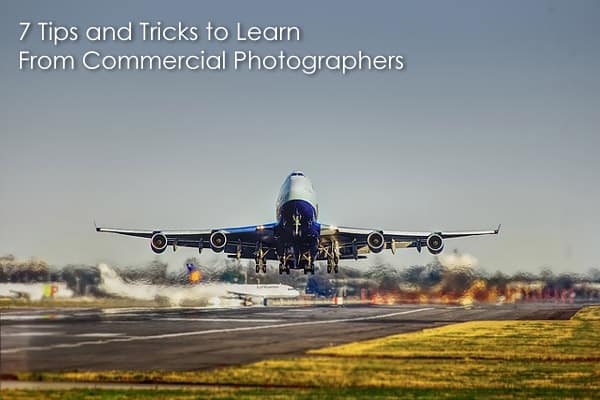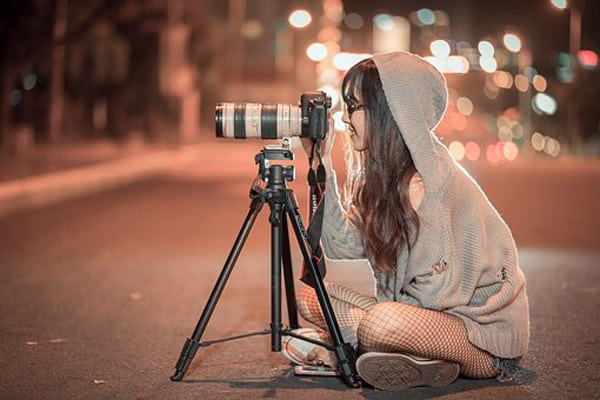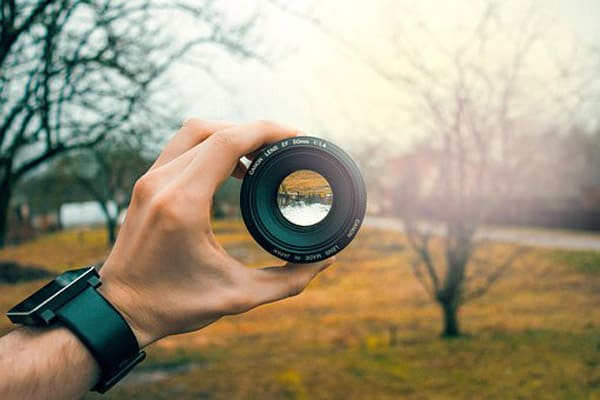The world of photography is an exciting one, and it is only getting more and more accessible as technology improves. Technically, anyone with a smartphone can be a photographer; whether or not you choose to be a “good” photographer is up to you.
Commercial photographers are some of the most sought after image-takers in the world as they have to be well-rounded, creative, and technically savvy. In other words, they know what they are doing.

For those of you who are just beginning your photography journey, or would like to take your picture-taking skills to a higher level, here are seven tips and tricks to learn from commercial photographers.
1. Create intentional imagery
Before the first shot is taken, one of the critical factors that commercial photographers consider is what the intended results of the photographs are. The best commercial photographers have produced images for a wide array of clients in a variety of industries, so they know that being clear about the intended results is key to creating photographs that work.
For example, a project for a hotel chain is going to need photographs that enticingly reveal their rooms and facilities. On the other hand, product shoots must demonstrate the quality and features of the goods. From the get-go, understanding the intended results of the photos ensures that you are creating a vision that combines purpose with creativity.

Even if you aren’t shooting commercial photographs for reputable businesses, it still is a great idea to think about what you are trying to show through your images. For portrait photography, consider what story you want to tell about your subject. For landscape photography, it might be showing a viewer a particular presence of nature. Each shoot will have a different intention; you need to establish it.
By understanding this element, you will reduce the likelihood of finding yourself just snapping thousands of photos for the sake of it. Instead, you will be able to narrow down your options to create intentional imagery.
2. Don’t be afraid of angles
The world is bombarded with thousands of images daily, so it takes an innovative photographer to capture a photograph that makes one stop, look, and feel.

As most people just point, shoot and capture a front-and-center shot, one of the ways commercial photographers make their work stand out is by embracing unusual angles. Rarely are commercial photographs shot in a head-on way, as angles add greater drama and increased interest to any shot — no matter what it is in focus.
For some photographs, this may require you to lay down on your back to find a perspective from down below or high up. A bird’s-eye view shot is different as your viewer rarely observes anything from this vantage point. Similarly, a bug’s-eye view has you shooting from down low and looking up at a subject to create an interesting perspective.
While a high angle view enables you to incorporate striking background elements, low angles are perfect for making a product or person appear larger than life and for affirming their force.
Furthermore, tilting the camera helps you to find unusual angles and can play a significant role in generating an original composition.
Your best bet is to spend some time trying out these different angles and seeing which ones work for your style of photography and which ones you can leave behind. The more comfortable you get photographing unusual angles, the more daring you will be in upcoming shoots.
Trial and error lead well into the next tip.
3. Grant yourself time
There is a reason that a lot of time and resources are spent coming up with and executing photography campaigns — they require them!
Ask any commercial photographer how much time is allocated from the first creative brief to the finished product, and you may be shocked to hear the timeline. When shooting products for clients, photographers don’t just go into the shoot with no prior research, understanding, or experience. In fact, it is the complete opposite — a lot of homework and preparation have been done before that first camera click.
It would be best if you had time to hone your skills and to learn the craft. You certainly need time to get to know your camera and other gear. Plus, hours are required to brainstorm your shoot’s intention, to conceive a plan of action, and to know what to expect in your shooting location. This is all before “shooting day.”
Obviously, for those who are happy just snapping away on their phone in the moment, this isn’t necessary; however, if you are looking to create more meaningful photos, then you are going to have to grant yourself time.
Even with the most thorough preparation possible, during the shoot, you can’t expect to get the perfect shot right away. Setting up and getting ready, experimenting with unusual angles, and finding the right composition always takes time. Don’t rush the process; otherwise, you are almost guaranteed to be left with an underwhelming stack of photos.
4. Gear does matter
When starting with photography, you may routinely hear that the gear you use doesn’t matter, and in some ways, this is true. If you have a budding love or appreciation for photography and want to get into it, then you should start with the tools that you already have at your disposal. However, this is where the whole “gear doesn’t matter” line stops.
The camera you choose to use isn’t going to convert your shots into outstanding art immediately, but it still undoubtedly matters. That isn’t to say that you have to go out and spend your entire paycheck on the fanciest camera on the market, but you do need to have something that works for the type of photos you are trying to take and that excites you.
Every photographer is different and, therefore, will recommend different cameras, lenses, and accessories. While it can seem overwhelming to know what you will actually use and what your photos require, the main thing to focus on is that your photo gear is working for you. Only you know how much weight you are willing to carry around, how intrusive your setup can comfortably be, and how much time you need to get it set up.
For this very reason, the camera bag of a product photographer and a street style photographer are going to include very different items. If you are looking to take product shots, then you are going to want a sturdy tripod that gives you the necessary stability to prevent blurring from occurring. Additionally, for commercial photographers, a macro lens is essential to be able to approach a product more intimately.

No matter what you choose to fill your camera bag up with, being excited about your photography gear is vital, as that enthusiasm will make it more likely that you will continually use it to shoot. This, in turn, will provide you with the opportunity to get to know the pieces intimately, enabling you to (eventually) take photographs without having to consider the mechanics.
5. Composition is the key to a viewer’s heart
The most important aspect of composition (arrangement) is the “rule of thirds” which requires splitting up your photo with two horizontal lines and two vertical lines and then placing the main components in the image on those lines, or at the points where they cross. This essential photography technique injects more energy and curiosity into your pictures as the viewer can view more than only the subject; instead, they are able to delve into the photo themselves unobstructedly.
If you have ever wondered why some photos are more “engaging” than others, there is a good chance that the rule of thirds is the answer.
When it comes to commercial photography, the best photographers know that their image needs to capture the attention of viewers, regardless of whether that is when they are flipping through a magazine or driving by a dominating billboard.

The composition of the photo is what makes all the difference and is why most opt to use a traditional rule of thirds technique. By showing people an image in this style, you are assisting their eyes in flowing intuitively and reasonably through the frame. What’s more, the rule of thirds helps to create a well-balanced shot which only increases its attractiveness.
Even if you are placing a product front-and-center in the shot, you can still utilize this rule by putting the objects at the intersections of the columns and rows. This will leave you with the necessary empty space required for balance and prevent the photo from appearing congested.
Generally, modern cameras have a setting that permits you to split up your LCD screen into the necessary grid for the rule of thirds, making it easier than ever to bring this golden rule into all of your shots.
6. Lighting helps you set the mood
One thing that separates the pros from the amateurs is the ability to handle lighting and to utilize it to set the appropriate mood. Given that (in their most accurate sense) photographs are renderings of light, it is only by mastering lighting that you will be able to produce outstanding work.
Some professionals are known for their ability to bring a craftsman’s touch to their work through illumination, while others are applauded for their ability to tell a story by their lighting choices.

Your first step should be to learn the basics of exposure, which is the combination of the three principal variables (shutter speed, aperture, ISO) that regulate the amount of light that is permitted to reach your camera’s sensor.
Generally, it is recommended that you make as much use of natural light as possible. However, if you do find yourself requiring a flash, never point it straight at your subject as it will generate the impression of flatness and will leave you editing a motionless image. Instead, by using an external flash, you will be able to reflect the light off a surface (like a wall or a ceiling) which will brighten a larger sphere, while also producing a more compelling array of tones.
Additionally, a diffuser will stop the light from becoming too harsh and jolting. Professional photographers use umbrellas and softboxes as diffusers, but you can start by creating your own with tracing paper and a cardboard box. Moreover, backlights are often used as a way to formulate unique and exciting effects.
As long as you know what you are doing, there are plenty of avenues for you to manipulate the lighting in an effort to make your photographs stand out and to demonstrate the unique way that you see the world.
7. Find your own style
That being said, with all rules and suggestions in photography, not all of them need to be applied to every photograph. However, before you go breaking all of them, learn how to use them effectively so that you know the right scenarios under which to practice them and when it will be more advantageous to throw them away.
Just like with most things in life, the best strategy is to copy the professionals and master the basics first so that you can understand their ways enough to break them. Being lazy in your learning and then calling the resulting images “your style” is not the way to up your photography game.
Gathering inspiration from professional photographers is key to opening yourself up to all the different ways a camera can be used; however, try not to compare your work with theirs until you are well on your photographing journey.
Don’t be scared to experiment, as trial and error is the key to figuring out your own style and enhancing your photos for good.
What aspects of photography are you currently struggling with? What are you looking to improve over the next few months? Let us know your experiences and any tips and tricks you may have in the comments below!
For more information on commercial photography, check out this article.









3 comments